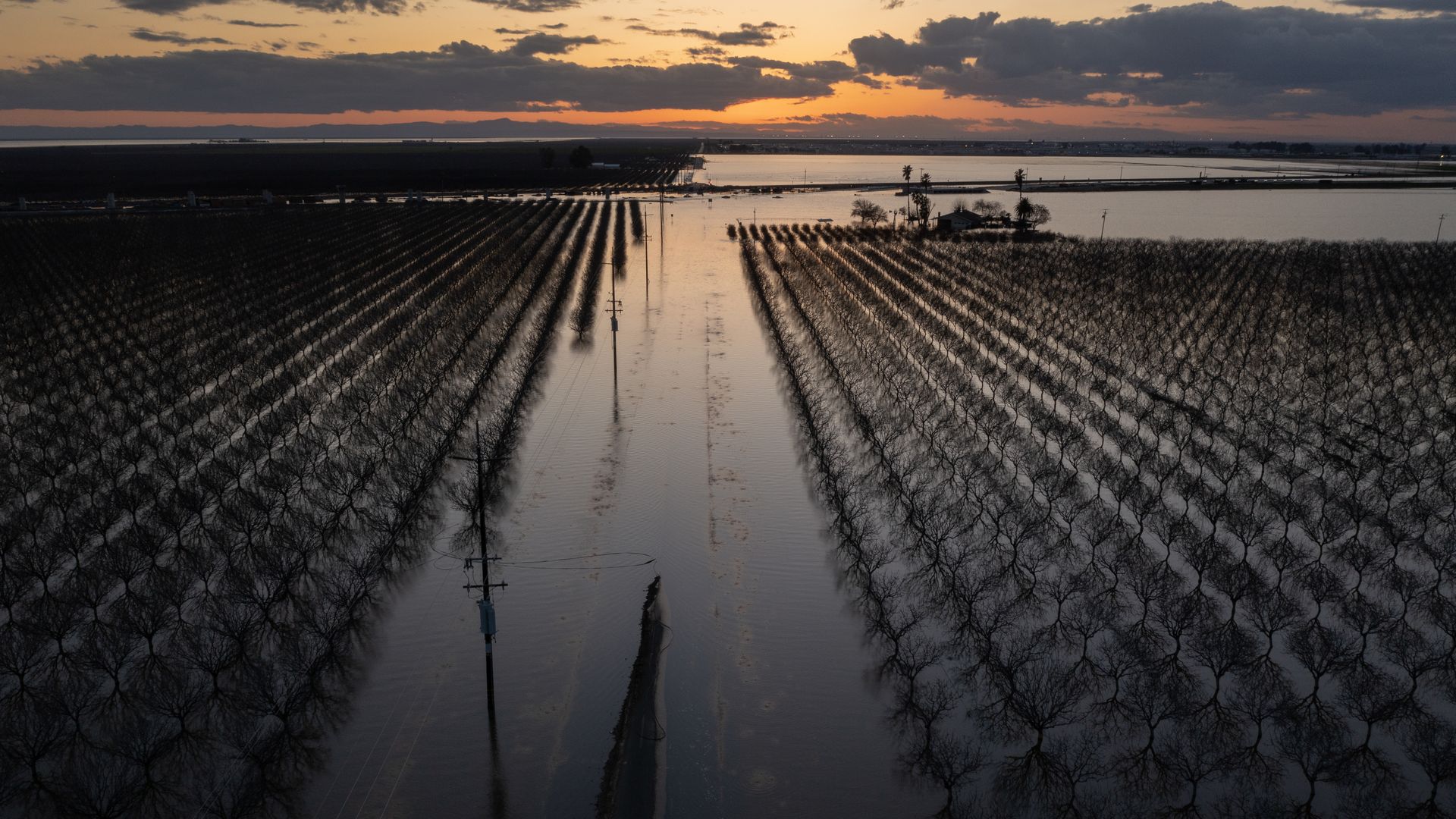California's looming snowmelt to resurrect lost Tulare Lake

- Andrew Freedman, author ofAxios Generate

In an aerial view, farms near the Tule River near Corcoran, Calif., are submerged on March 23. Photo: David McNew/Getty Images
California's blockbuster wet season, with another powerful bomb cyclone currently swirling off the coast, has built up a near-record-large Sierra Nevada mountain snowpack.
Why it matters: While this snow has many benefits, including replenishing depleted reservoirs, it is creating damaging floods that are sure to worsen.
- An area of significant concern for the melt season is associated with the southern Sierra snowpack, which drains into the San Joaquin Valley.
- It is there that county officials and landowners are already being forced to make agonizing decisions about which lands to flood and which to keep dry — and disputes are breaking out between landowners.
The big picture: When the state's formal snow survey takes place on April 1, typically the peak for the season, California is likely to set an all-time record for the largest snowpack. This is measured by how much water it contains, known as snow water equivalent.
- As of Monday, the state's snowpack had an average snow water equivalent of 58.2 inches, official data shows. This was 227% of the April 1 average.
- The departure from average is highest throughout the Southern Sierra, which had an average snow water equivalent of 60.5 inches. That was 283% of the April 1 average.
- This is a red flag: farmers, ranchers and residents living downstream are at serious risk of flooding once snowmelt begins in earnest.
- This is especially the case if there is a rapid melt due to a mild storm that brings more rain than snow, or a heat wave occurs that speeds up melt rates.

Zoom in: Already, Mother Nature has moved to reclaim what once was hers: Tulare Lake. At one time, this was the largest body of freshwater west of the Mississippi River.
- Human intervention in the form of levees and dams diverted its source waters, including the Kings, St. John's and Tule Rivers.
- The last time the lake re-established itself was in 1982-83, which is also the previous snowpack record-holder.
- The lake covered 82,000 acres that year, per the L.A. Times.
Threat level: Already this year, thousands of acres have flooded — inundating farmlands producing tomatoes, cotton, alfalfa, pistachios and more — and threatening livelihoods.
- Depending on how extensive they are, the floods could affect food prices given California’s role as the country's top agricultural-producing state.
- How rapidly the snow melts will be a key determinant of how severe the flooding gets.
- Regardless of the rate of snowmelt, this region is likely to see a long-lasting battle with water, completing the area’s dizzying lurch from drought to flood.
- Towns including Tulare, Alpaugh, Allensworth and Corcoran, are among those most at risk.
What they're saying: Daniel Swain, a UCLA climate scientist, said in a YouTube storm briefing Monday that the nature of landownership in the Joaquin River Basin makes the area more vulnerable to flooding.
- "There's some very powerful agricultural interests who essentially because of the nature of the land ownership, have a certain amount of power in terms of engaging in unilateral actions that might actually harm adjacent communities," he said, noting that some are trying to influence who floods first.
- "Unfortunately, the reality is all of these areas are likely going to flood eventually this spring as the flooding continues to worsen."
- Swain said it is the low-income and farm-worker communities that are most at risk from floods, though floodwaters could eventually spread into larger population centers.
- "There is more and more water pouring into the Tulare Lake Basin and that water is not going to be leaving the basin for the foreseeable future."
Context: Studies, including work that Swain has been involved in, show that climate change raises the odds of California weather whiplash events, from drought to flooding and back again.
- This is noteworthy, since the state was already known for its feast or famine precipitation regime.
- Climate change is also worsening extreme precipitation events.